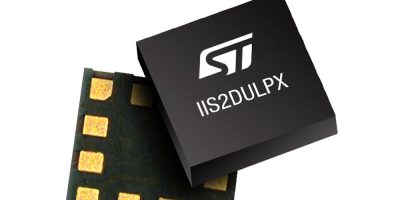Renesas has introduced the RA2L2 microcontroller (MCU) group with ultra-low power consumption and the industry’s first support for the new UCB-C Revision 2.4 standard. Based on a 48-MHz Arm Cortex M23 processor, the new MCUs offer a rich feature set that makes them ideal for portable devices and PC peripherals such as gaming mice and keyboards.
AI
ST combines activity tracking and high-impact sensing in miniature AI-enabled sensor
ST has revealed an inertial measurement unit that combines sensors tuned for activity tracking and high-g impact measurement in a single, space-saving package. Devices equipped with this module can allow applications to fully reconstruct any event with high accuracy and so provide more features and superior user experiences. Now that it’s here, markets can expect powerful new capabilities to emerge in mobiles, wearables, and consumer medical products, as well as equipment for smart homes, smart industry, and smart driving.
ST reveals industrial-grade accelerometer with edge AI and ultra-low power
ST’ IIS2DULPX industrial MEMS accelerometer combines machine learning, power saving, and capability to operate at high-temperature, facilitating intensive sensorisation for smarter, data-driven operations and decision making in asset tracking, robotics, and factory automation, as well as industrial-safety equipment and healthcare devices.
Synaptics launches ultra-low-power Wi-Fi/Bluetooth SoC family for embedded Edge AI IoT
Synaptics has extended its Veros Triple Combo connectivity portfolio with the SYN461x family of ultra-low-power (ULP) Wi-Fi 2.4/5/6 GHz, Bluetooth 6.0 and Bluetooth Low Energy (BLE), and IEEE 802.15.4 (Zigbee/Thread) systems on chip (SoCs). Designed for the embedded Edge AI Internet of Things (IoT), the SYN461x is optimised for power, system integration, size, and rapid time to market while delivering rate-over-range performance and seamless interoperability. The versatile Matter-compliant SoCs offer advanced Bluetooth features, such as Channel Sounding and LE Audio—including Auracast. The SYN461x specifically targets consumer and industrial applications and is tailored for devices such as wearables, smart watches, audio speakers and headsets, home appliances, security cameras, asset trackers, and factory automation.
About Weartech
This news story is brought to you by weartechdesign.com, the specialist site dedicated to delivering information about what’s new in the wearable electronics industry, with daily news updates, new products and industry news. To stay up-to-date, register to receive our weekly newsletters and keep yourself informed on the latest technology news and new products from around the globe. Simply click this link to register here: weartechdesign.com







